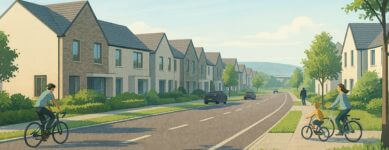A Building Energy Rating (BER) is Ireland’s official efficiency label for homes and commercial properties in an effort to enhance sustainability. Graded from A1 (most efficient) to G (least efficient), the certificate estimates how much energy a building will use for heating, hot water, ventilation and lighting under standardised conditions. Since 2009 a valid BER has been legally required when a property is sold or rented, making it a key metric for buyers, landlords, lenders and policymakers alike.
How a BER Is Calculated
BER assessments follow the Sustainable Energy Authority of Ireland’s (SEAI) Dwelling Energy Assessment Procedure (DEAP). Qualified assessors input dozens of data points, including:
- Fabric performance of walls, roof, floors and windows
- Space- and water-heating systems (boilers, heat pumps, controls)
- Solar-gain and shading characteristics
- Ventilation method and airtightness test results
- On-site renewables such as photovoltaic panels
The software converts these inputs into an annual primary-energy demand (kWh/m²/yr) and associated CO₂ emissions, then slots the dwelling onto the A-to-G scale.
Understanding the Rating Bands
- A-rated (A1–A3): ≤ 75 kWh/m²/yr. New-builds today typically achieve A2; Castlethorn schemes aim for A2 or better to future-proof running costs.
- B-rated: 76–150 kWh/m²/yr. Common in post-2010 homes; solid basis for green-mortgage discounts.
- C-rated: 151–225 kWh/m²/yr. Typical of homes built in the early 2000s before major Part L upgrades.
- D–G: 226 kWh/m²/yr and above. Older stock with poor insulation and dated heating; often targeted by retrofit grants.
Why BER Matters
- Lower bills: Upgrading from a C- to an A-rated home can save roughly €800–€1 200 per year on energy costs.
- Stronger valuations: Lenders increasingly factor BER into loan-to-value ratios and interest-rate incentives.
- Regulatory compliance: New Nearly Zero-Energy Buildings (NZEB) rules require at least A2 performance, and proposed EU directives will push minimum efficiency standards higher after 2030.
- Green finance: Properties that meet A-rating thresholds align with the EU Taxonomy, broadening access to green bonds and sustainability-linked loans.
How to Find or Verify a BER
- Check the advisory report: Every BER certificate comes with a tailored upgrade roadmap.
- Search the SEAI register: Publicly available at seai.ie, using the BER number or property address.
- Confirm assessor credentials: Only SEAI-accredited professionals may issue certificates.
Simple Ways to Improve a BER
- Install high-performance insulation in attics, walls and floors.
- Replace single- or double--glazed units with low-U-value triple glazing.
- Upgrade to a condensing gas boiler, air-to-water heat pump or district-heating connection.
- Add rooftop solar PV for electricity and/or solar thermal for hot water.
- Fit smart heating controls and ensure good airtightness, then introduce demand-controlled ventilation to maintain healthy air quality.
Castlethorn’s Commitment to A-Rated Living
All current Castlethorn developments, including Woodbrook cost-rental and Adamstown Phase 3, are designed to achieve at least BER A2. We combine a fabric-first approach with modern methods of construction and renewable technologies, reducing operational energy demand by around 60% versus 2005 standards.
For a deeper dive into our methodology, see Sustainability in Construction and Modern Methods of Construction (MMC) Explained.
Key Takeaways
A BER isn’t just a compliance box-tick; it directly influences running costs, lending terms and long-term asset resilience. Whether you’re a first-time buyer comparing homes or an investor evaluating portfolio risk, understanding the BER scale will help you make smarter, future-proof decisions.
Have questions about energy efficiency in Castlethorn homes? Contact our sustainability team or explore current developments on our website.




